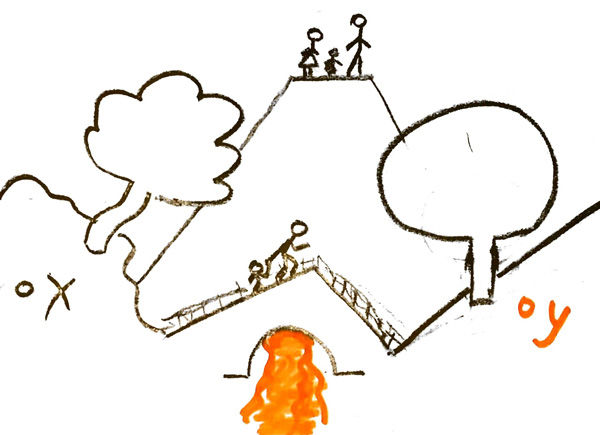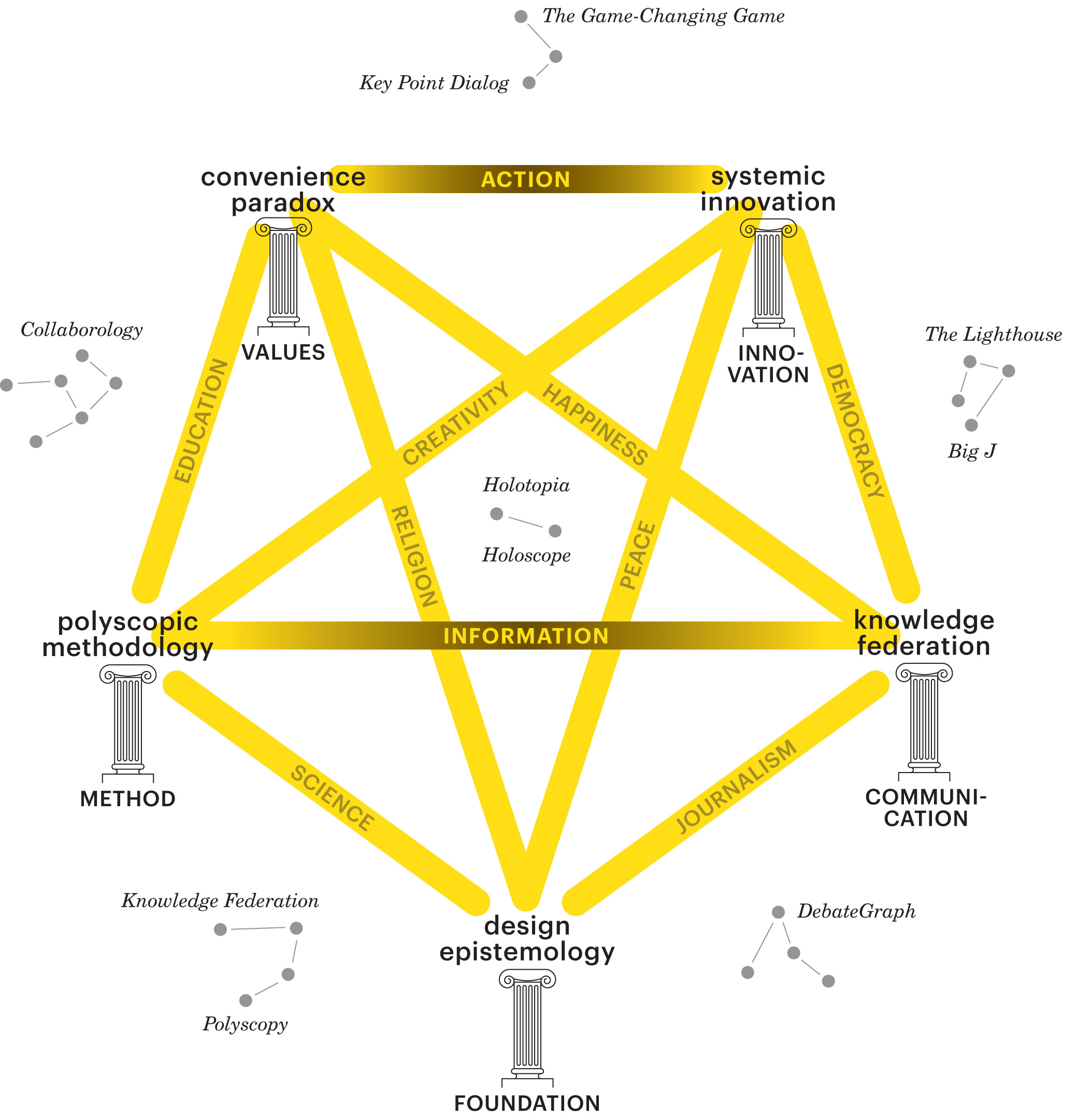Difference between revisions of "N-ideograms"
m |
m |
||
| Line 67: | Line 67: | ||
</div> | </div> | ||
<div class="row"> | <div class="row"> | ||
| − | <div class="col-md-3"><font size="+1">Holotopia ideogram shows how to create a | + | <div class="col-md-3"><font size="+1">Holotopia ideogram shows how to create a better future.</font></div> |
<div class="col-md-7"> | <div class="col-md-7"> | ||
<!-- ANCHOR --> | <!-- ANCHOR --> | ||
<span id="Holotopia"></span> | <span id="Holotopia"></span> | ||
<p> [[File:Holotopia-id.jpg]] <br><small><center>Holotopia ideogram</center></small></p> | <p> [[File:Holotopia-id.jpg]] <br><small><center>Holotopia ideogram</center></small></p> | ||
| − | <p>The Holotopia ideogram comprises five pillars representing <em><b>holotopia</b></em>'s <em><b>five insights</b></em>; which resulted | + | <p>The Holotopia ideogram comprises five pillars representing <em><b>holotopia</b></em>'s <em><b>five insights</b></em>; which resulted by applying the procedure I've just described to five judiciously chosen <em><b>pivotal</b></em> categories or themes; and showed that when we base them on <em><b>knowledge</b></em> (and not on <em><b>belief</b></em>)—our comprehension and handling of life's basic themes will change beyond recognition!</p> |
| − | < | + | <p>And when we considered other themes—including creativity, religion, education, happiness and politics—in the context of the <em><b>five insights</b></em>—<em>they too</em> appeared in a completely new light; so we created the <em><b>ten themes</b></em> to illustrate that. </p> |
| − | <p> | + | <p>The stars in Holotopia ideogram represent [[prototype|<em>prototypes</em>]]; and point out that when <em>elevate</em> ourselves above "the world"—we'll be able to also <em>act</em> as our situation requires; instead of only reacting.</p> |
| − | <p>The stars in | ||
</div> | </div> | ||
</div> | </div> | ||
Revision as of 11:55, 26 October 2023
Contents
Federation through Ideograms
Ideograms help us see things whole.
Aurelio Peccei summed up in One Hundred Pages for the Future: “The arguments posed in the preceding pages […] point out several things, of which one of the most important is that our generations seem to have lost the sense of the whole. From all points of view, this loss represents a backward step, an unfortunate involution—especially since it has occurred at the very moment when many systems, old and new, are expanding and intertwining, thus deepening the complexity of the great metasystem of the world which gives humanity, willy-nilly, a substantial unity. A sense of the global and universal harmony, which is characteristic to philosophical and religious thought and is the eternal quest of science, has also become an indispensable basis for informed political action. That sense must be restored to present-day society.”
Modernity ideogram
The Modernity ideogram depicts our society as a bus and our information as its candle headlights.
How could such an uncanny error ever be made? Certainly not by people who considered the options! They must have simply adopted this ludicrous illumination source—which had been created for a different function; with out-of-date technology.
In his 1969 MIT report and call to action—to institute a transdiscipline—Erich Jantsch quoted Norbert Wiener, the iconic progenitor of cybernetics:
“There is only one quality more important than ‘know-how’…… This is ‘know-what’ by which we determine not only how to accomplish our purposes, but what our purposes are to be.”
Academic disciplines cannot provide us know-what; and the media informing, such as it is, won't do it either. A system that provides us knowledge must combine disciplinary and other evidence; it must transcend academic and cultural fragmentation; it must communicate to the public with the authority of science—in ways that are beyond the modalities of outreach that the sciences are able to produce.
In One Hundred Pages for the Future, in 1981, based on a decade of The Club of Rome’s research into the future prospects of mankind, Aurelio Peccei—this global think tank’s leader and co-founder—concluded: “It is absolutely necessary to find a way to change course.”
So why not change those ugly 'headlights'?
And here you are already sensing that effortless optimism that distinguishes holotopia: We do not need to occupy Wall Street; it is not necessary to wrestle with "the 1%"; the "way to change course" is in our hands! We scientists, we the publicly sponsored intellectuals—already have the mandate to instruct us the people how to use our minds; and to prescribe what information needs to be like.
Information ideogram

The Information ideogram is an “i” (for "information"), composed as a circle on top of a rectangle, inscribed in a triangle. The rectangle stands for a myriad of documents; and also for looking at a theme from all sides. The circle stands for the point of it all; the triangle symbolizes the metaphorical mountain. This ideogram points to the fact that information is incomplete without the point; and that a myriad of documents can be pointless.
On the more technical side, the Information ideogram depicts the information holon as a new and up-to-date notion of a basic unit or "piece" of information. A holon is both a whole in itself and a piece in a larger whole. When a myriad of documents are federated to produce the point—this point can then be used to compose a higher-order holon; so that holons can be combined into a holarchy—which is what the mountain stands for; and knowledge federation too.
The mountain enables us to rise above "the information jungle"; and to see things whole.
Knowledge Federation ideogram
The Knowledge Federation ideogram comprises the realm of experience or "the real world" on its left, and the realm of ideas on its right; and there is also the bridge joining those two sides, and the metaphorical mountainin the background.
"The Matrix is the world that has been pulled over your eyes to blind you from the truth", Morpheus told Neo; to introduce him to the dystopian vision that The Matrix epitomized. As long as "the world" is our only reference—we can only adapt to it; no matter how dysfunctional and outright harmful our systems may have become! And it is only when we have an independent reference system—that we become capable of improving the world.
Albert Einstein shared his "epistemological credo" in Autobiographical Notes:
“I see on the one side the totality of sense experiences and, on the other, the totality of the concepts and propositions that are laid down in books. […] The system of concepts is a creation of man, together with the rules of syntax, which constitute the structure of the conceptual system. […] All concepts, even those closest to experience, are from the point of view of logic freely chosen posits, just as is the concept of causality, which was the point of departure for [scientific] inquiry in the first place.”
We may begin to federate knowledge by looking at the realm of experience or "the real world" from a high point on the mountain; and identify a theme that demands attention; and then take that theme over the bridge to the realm of ideas, along with the data that might provide it a suitable context; and theorize it and comprehend it; and then take the result back over the bridge and act in an informed way.
Science gave us "Newton's laws" and other "laws of nature"; and empowered us to comprehend the natural world in terms of simple insights and principles. Knowledge federation empowers us to comprehend all themes in a manner we can rely on.
Holotopia ideogram
The Holotopia ideogram comprises five pillars representing holotopia's five insights; which resulted by applying the procedure I've just described to five judiciously chosen pivotal categories or themes; and showed that when we base them on knowledge (and not on belief)—our comprehension and handling of life's basic themes will change beyond recognition!
And when we considered other themes—including creativity, religion, education, happiness and politics—in the context of the five insights—they too appeared in a completely new light; so we created the ten themes to illustrate that.
The stars in Holotopia ideogram represent prototypes; and point out that when elevate ourselves above "the world"—we'll be able to also act as our situation requires; instead of only reacting.



